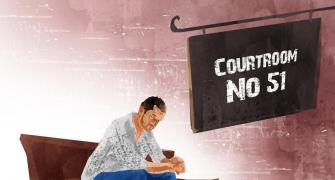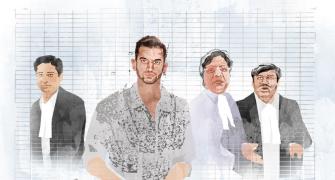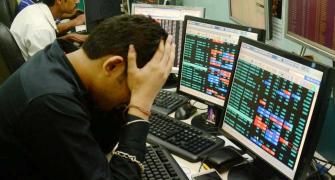One of the high points of the proceedings was when Indrani Mukerjea's lawyer smartly utilised Dr Zeba Khan's expert status to pose her A Most Curious Question.
He asked her if a skull can grow new teeth, even after the person, who it belonged to, had died, three years before.
We can be sure that the discrepancy between the number of teeth discovered in the skull unearthed in 2012 and the skull shown in court in September 2019 will come up soon in Courtroom No 51.
Vaihayasi Pande Daniel reports from the Sheena Bora Murder Trial.

After a spring, a summer, a monsoon, a winter and yet another spring of dull witnesses, of perhaps neither much consequence nor interest, in the Sheena Bora trial, the tail end of the hot summer of 2024 brought to the witness box Dr Zeba Khan, PW 91.
And a wee round of excitement.
On July 10, Dr Khan, who is an assistant professor of anatomy at the Sir Jamshedjee Jeejeebhoy Group of Hospitals, south central Mumbai, arrived a tad late in court for the start of her afternoon cross-examination by the defence.
At 2.55 pm she had still not shown.
Special CBI Judge Samarendra Prakashrao Naik-Nimbalkar, in Courtroom No 51, Mumbai city civil and sessions court, Kala Ghoda, south Mumbai, was beginning to look for her, slightly perturbed at the delay; he runs a very tight ship.
She ambled in past three. In a long black kurta, black chunni, bright blue salwar, eye-catching electric red shoes, vermillion lipstick to match her footwear -- a short, portly woman, wearing glasses -- she cut an intriguing figure.
More interesting was her relaxed, walk-in-the-park approach to the trial proceedings, news of which had once again made national headlines, in June, when it was reported that the skeletal remains Dr Khan had attempted to identify in 2012, as an anatomical expert, and not a forensic expert, could not be accessed or found!
'Sheena Bora case: Bones, remains of victim recovered by cops has gone missing' flashed all over the news then.
The CBI admitted that it was a temporary mix-up and the skeletal remains were in its possession, as per procedure, in one of the CBI malkhanas (a place where items relating to a case are kept). After again going through the malkhana, the CBI submitted that the bones were lying in the malkhana and they (were missed out because) they were not cited along with the chargesheet, the court was told July 10, Wednesday.
Accused No 1 Indrani Mukerjea's lawyer Ranjeet Vishnupant Sangle said he would be filing an application for the production of those articles.
Only Sangle had plans to cross-examine Dr Khan, Wednesday. He did so, like he usually does, thoroughly.
She took most of the questions he forcefully peppered, rat-tat-tat, at her in her stride, unruffled, rarely disagreeing with him... well because there was nothing really to disagree about. And when she did, it was without heat, dust or aggro.
One of the high points of Wednesday's proceedings was when Sangle smartly utilised Dr Khan's expert status to pose her A Most Curious Question.
He asked her if a skull can grow new teeth, even after the person, who it belonged to, had died, three years before.
Slightly bemused, Dr Khan shook her head slowly and said firmly, "No, teeth would not have grown."
We can be sure that the discrepancy between the number of teeth discovered in the skull unearthed in 2012 and the skull shown in court in September 2019 will come up soon in Courtroom No 51.
The second high point happened a little earlier in that day, before the afternoon cross examination. So, we would need to backtrack a little...
It was about an e-mail that Judge Naik-Nimbalkar read out in court in the first session, in Dr Khan's presence, from her alleged brother, whose full name was not accessible.
In the e-mail, this relative of Dr Khan's, who was allegedly in a property dispute with her, claimed, again allegedly, Dr Khan had shown and circulated photographs of Sheena's remains to their mutual relatives.
Further, it accused, she had allegedly intentionally caused for the remains to disappear and, of late, had 'amassed' a disproportionate amount of additional property and wealth in her possession and this informant was in the process of allegedly disclosing this to the Income Tax department.
Since the remains, which the e-mail had referred to, had already been found -- and were never lost -- Dr Khan had no particular reaction or response. But the e-mail was responsible for pushing the cross-examination to the afternoon, while the prosecution checked with the CBI on whether they should proceed with this witness or go onto the next.
Meanwhile Accused No 1, Indrani Mukerjea, who had chosen to wear lawyer's black and whites, with perky white high-heels was planning a trip to the UK. Or at least she hoped to.
Sangle approached the bench requesting permission for her travel to England to solve some property-related matters.
CBI's Special Public Prosecutor C J Nandode could not see why it was necessary and said Accused No 1 had given no particulars on what she planned to do over there.
Sangle argued that it was pretty obvious why she would need to visit England.
She was a British citizen, since 2013, and Indrani wanted to make a trip back to her "country of nationality".
She had property and bank matters to deal with and bank accounts that had become "dormant".
The judge requested more information and details before he could come to a decision.
By 3 pm the CBI had sent their green signal and the cross examination was slated to start up, and did so when Dr Khan made her appearance.
Not expecting a resolution in this matter so quickly, from the CBI, that day, Indrani had headed home and had to be called back.
She returned, clippety-clop, nearly 45 minutes later, breathless, hair flying, and all charged up, as she normally is, to sit in the accused box in the back, with always-amiable-looking Peter Mukerjea, Accused No 4 and former partner No 3. Indrani's energy is something to behold. It is hard to recall meeting a woman more full of beans.
Across the room, Dr Khan's efficient and calm attitude in the stand -- that other witnesses approach nervously -- could perhaps be explained by the fact that for her depositions like this are routine-ish.
She makes these visits to courts for the purpose of supplying evidence in 'MLCs' (medico-legal cases pertaining to an injury or medical condition in which law enforcement agencies must investigate), at least once in a year, because skeletal remains can be sent to her department for analysis from any of the nearby police stations in Maharashtra.
Trained in Aligarh at the Jawaharlal Nehru Medical College, which is attached to the prestigious Aligarh Muslim University, she moved to Mumbai after marriage and began work at the JJ hospital where she has been at for nearly 16 years.
It was an MLC from the Pen police station, Raigad district, 12 years ago that put Dr Khan into the tragic Sheena Bora murder picture, which has now become a long, long sad saga, drawn out over a dozen painful years. And the cast of the Sheena Bora trial, like the pictorial representation of the characters of a mini-series, with scads of seasons, keeps elongating horizontally rapidly.
In May 2012, a passerby named Ganesh Lakshman Dhene had gone to pluck mangoes in a copse of mango trees in rural Gagan Khurde, near Pen, and discovered an apparently half-charred skeleton, that was allegedly Sheena's.
The body's postmortem was done on the day of the discovery of the corpse, on site, by local primary health centre physician, Dr Sanjay Atmaram Thakur, and he sent a few of the bone pieces in jars for further testing to the JJ Hospital in Mumbai.
That was how these jars -- which contained a burnt piece of the upper end of the femur (upper leg bone), some broken pieces of ribs, teeth, part of a fibula (lower leg bone), among other pieces -- landed up on the desk of Dr Khan in 2012.
The specialist of anatomy described to the court, Wednesday, that because the bones were charred, and the sample was missing crucial remains, that could help in identifying the sex and age of the skeleton, she was unable to provide substantive answers to the queries relating to the identity of the victim that came from Pen police station.
Sangle cemented home, via his line of questioning, this fact.
Sangle: "In your report have you answered all the four questions (asked)?"
Dr Khan: "I had answered whether male or female. I had answered age of deceased. How many days have passed since deceased is not under our jurisdiction as it does not come under anatomy (she later added, "That answer is given by forensics"). And the cause of death cannot be opined upon."
Sangle: "Would it be correct to say, after your thorough examination, your opinion in regards to all of these questions, like sex, age, cause, cannot be opined or was inconclusive?"
Dr Khan: "The bones which are needed to determine the sex or age were not sent."
Indrani's lawyer also disputed that the bones were burnt. "None of these bones were in a burnt or charred condition," he declared.
The cross examination of Dr Thakur in June 2019 by Peter's late lawyer Shrikant Shivade had the junior doctor admit that the body was perhaps not burnt because the skeleton was intact, which does not occur after burning.
But Dr Khan was definite about the fact that the bone samples she received were burnt or charred.
They disagreed too on whether the samples that arrived for her inspection were in sealed jars. Sangle adamantly stated the jars were not sealed.
Apparently, a typed report, of the nature Dr Khan drew up in 2012, after she signed it, and marked her initials against any changes made by hand (if need be), is usually sent back to the police station that had asked for it. Sangle checked if that had happened in this case too.
Dr Khan clarified that it had, but she had also sent the report, later, to two separate individuals at the Khar police station, north west Mumbai, on two different dates in August 2015, when JJ's dean received a request to do so.
Sangle subsequently dwelt on the maceration of the bone samples, Dr Khan had been sent from Pen. Maceration is an anatomical technique that facilitates the dropping off of soft tissue from a bone sample, without hurting it, so it can be further examined.
Sangle: "Dr Khan, would it be correct to say that if the bones were not in a burnt and charred condition, you would have kept them for maceration?"
She nodded.
Sangle attempted to confirm: "But you had placed all the bones for maceration."
Dr Khan disagreed.
Towards the end, Sangle fished about, like an ambitious angler looking for a huge fish, resourcefully trying to employ the witness for his own purposes, asking her about cut skulls and brain matter, when she had only seen a few bits of ribs and leg parts.
He met with quite a few stern objections from the judge, who would not allow this meandering off course, like the trial was taking a wild stroll about a vast stadium.
CBI Special Prosecutor Nandode did not have to even get up on his feet to object, because Judge Naik-Nimbalkar kept Sangle on a short leash and conscientiously steered him right out of the stadium, and back onto the appropriate tight circuit.
The judge told him, tiredly, time and again, "You cannot put words in her mouth... She does not know!... How will she know?? It is not relevant."
But feisty Sangle was not to be deterred. He finally met with some success when he asked about the skull growing new teeth, which was met with much gleeful elation from Indrani in rear of the court.
The cross had lasted a little short of two hours.
The weather was pleasant Wednesday at court, even though the fans had not much reach. A few murky puddles hung about outside the building. The court corridors looked the same albeit cleaner. A dog snored from noon till 5.30 pm on the third stair landing. A Shobha canteen chaiwallah of the court offered me a cutting chai on the stairs going up. An extremely attractive African woman, her hair in cornrows, was being led back to jail by a few lady cops. A large family of several children and elderly relatives, many in burkhas, was traipsing up the stairs to visit an accused.
I was returning to Courtroom 51 after 10 months. A few chairs had been added. The countless (I do know the number actually) trunks of court papers seemed better organised. And thankfully those awful suffocating grimy enclosures of plexiglass had been disbanded. It felt like I had never been away. And I was happy to back for this wee interlude.
As I walked home, I mulled over how, like so many things, you can even get attached and feel affectionately towards a dusty Mumbai city courtroom, that you had been in and out of for nearly eight years, before-COVID, in COVID, after-COVID and through so many stages in your life.
Feature Presentation: Rajesh Alva/Rediff.com










